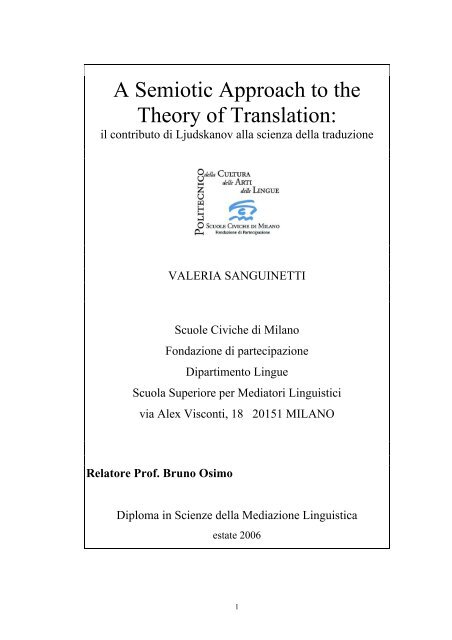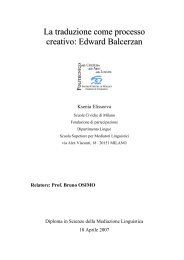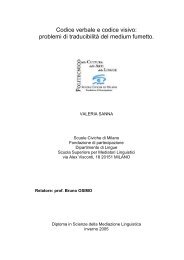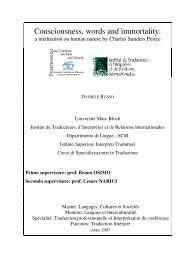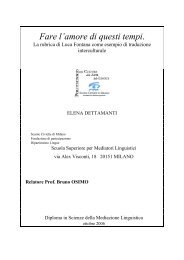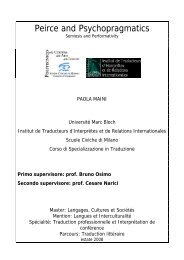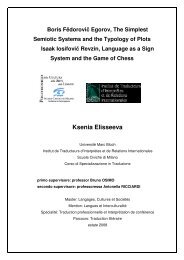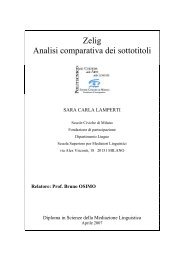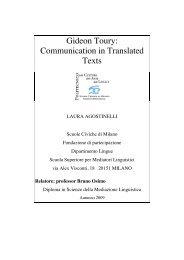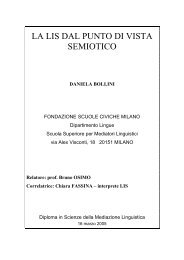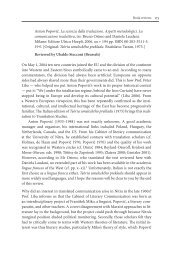A Semiotic Approach to the Theory of Translation: - Bruno Osimo ...
A Semiotic Approach to the Theory of Translation: - Bruno Osimo ...
A Semiotic Approach to the Theory of Translation: - Bruno Osimo ...
Create successful ePaper yourself
Turn your PDF publications into a flip-book with our unique Google optimized e-Paper software.
A <strong>Semiotic</strong> <strong>Approach</strong> <strong>to</strong> <strong>the</strong><br />
<strong>Theory</strong> <strong>of</strong> <strong>Translation</strong>:<br />
il contribu<strong>to</strong> di Ljudskanov alla scienza della traduzione<br />
VALERIA SANGUINETTI<br />
Scuole Civiche di Milano<br />
Fondazione di partecipazione<br />
Dipartimen<strong>to</strong> Lingue<br />
Scuola Superiore per Media<strong>to</strong>ri Linguistici<br />
via Alex Visconti, 18 20151 MILANO<br />
Rela<strong>to</strong>re Pr<strong>of</strong>. <strong>Bruno</strong> <strong>Osimo</strong><br />
Diploma in Scienze della Mediazione Linguistica<br />
estate 2006<br />
1
© Ljudskanov e Language Sciences – Blooming<strong>to</strong>n, Indiana 1975<br />
© Valeria Sanguinetti per l’edizione italiana 2006<br />
2
ABSTRACT IN ITALIANO<br />
Ljuduskanov, diret<strong>to</strong>re del proget<strong>to</strong> di Traduzione Meccanica e<br />
Linguistica Matematica a S<strong>of</strong>ia negli anni ’60, si occupa sia di<br />
traduzione meccanica sia di teoria della traduzione. I suoi scritti<br />
presentano punti di contat<strong>to</strong> con alcuni grandi studiosi del Novecen<strong>to</strong>.<br />
Analogamente a Revzin, Ljudskanov assegna una grande importanza<br />
all’informazione invariante, intesa come elemen<strong>to</strong> comune tra i vari<br />
tipi di traduzione. Costui utilizza come pun<strong>to</strong> di partenza per le sue<br />
osservazioni lo schema della comunicazione monolingue del suo<br />
contemporaneo Jakobson e, come questi, inserisce la traduzione<br />
all’interno della semiotica. Il ricerca<strong>to</strong>re bulgaro sostiene che la<br />
traduzione, a qualsiasi genere appartenga il tes<strong>to</strong>, consiste in un<br />
processo creativo, tesi condivisa con lo slovacco Popovič. Entrambi<br />
prendono in considerazione il problema che sorge quando si ha una<br />
differenza temporale tra pro<strong>to</strong>tes<strong>to</strong> e metates<strong>to</strong>. Dalla analisi di<br />
Ljudskanov emerge per la prima volta la concezione di informazione<br />
necessaria alla traduzione.<br />
3
ENGLISH ABSTRACT<br />
Ljudskanov – direc<strong>to</strong>r <strong>of</strong> <strong>the</strong> Machine <strong>Translation</strong> and Ma<strong>the</strong>matical<br />
Linguistics Project in S<strong>of</strong>ia during <strong>the</strong> 1960s – deals both with<br />
machine translation and with <strong>the</strong> <strong>the</strong>ory <strong>of</strong> translation. His writings<br />
show some points in common with some important scholars <strong>of</strong> <strong>the</strong> XX<br />
century. Similarly <strong>to</strong> Revzin, Ljudskanov gives great significance <strong>to</strong><br />
invariant information, considered as a common element among <strong>the</strong><br />
various types <strong>of</strong> translation. He uses Jakobson’s communication<br />
model as <strong>the</strong> starting point for his observations and, like <strong>the</strong> Russian<br />
linguist, he is convinced that <strong>the</strong> place <strong>of</strong> translation as a science is in<br />
semiotics. The Bulgarian researcher claims that translation, no matter<br />
what genre it belongs <strong>to</strong>, is a creative process and he shares this<br />
opinion with <strong>the</strong> Slovak Popovič. They both reflect on <strong>the</strong> problem<br />
caused by <strong>the</strong> time difference between <strong>the</strong> source text and <strong>the</strong> target<br />
text. Ljudskanov’s analysis for <strong>the</strong> first time highlights <strong>the</strong> idea <strong>of</strong><br />
information necessary for translation.<br />
4
RESUMEN EN ESPAÑOL<br />
Ljudskanov, que en los años 60 dirigió el proyec<strong>to</strong> de Traducción<br />
Au<strong>to</strong>mática y Lingüística Matemática en S<strong>of</strong>ía, se dedica tan<strong>to</strong> a la<br />
Traducción Au<strong>to</strong>mática como a la Teoría de la Traducción. Sus obras<br />
presentan pun<strong>to</strong>s en común con otros grandes investigadores del siglo<br />
XX. Ljudskanov, análogamente a Revzin, o<strong>to</strong>rga gran importancia a la<br />
información invariante, en cuan<strong>to</strong> elemen<strong>to</strong> que los distin<strong>to</strong>s tipos de<br />
traducción tienen en común. Como pun<strong>to</strong> de partida para sus<br />
observaciones, utiliza el esquema de la comunicación monolingüe de<br />
su contemporáneo Jakobson y, tal como él, considera que la Ciencia<br />
de la Traducción forma parte de la Semiótica. El investigador búlgaro<br />
sostiene que la traducción, sea cual fuere el género al que pertenece,<br />
es un proceso creativo, tesis que comparte con el eslovaco Popovič.<br />
Ambos <strong>to</strong>man en consideración el problema que surge cuando hay<br />
una diferencia temporal entre el tex<strong>to</strong> de partida y el tex<strong>to</strong> de llegada.<br />
Del estudio de Ljudskanov se desprende, por primera vez, el concep<strong>to</strong><br />
de información necesaria para la traducción.<br />
5
Sommario<br />
1 Prefazione 7<br />
1.1 Biografia 7<br />
1.2 Isaak Iosifovič Revzin e Vik<strong>to</strong>r Jul´evič Rozencvejg 9<br />
1.3 Roman Jakobson 11<br />
1.4 An<strong>to</strong>n Popovič 13<br />
2 Traduzione con tes<strong>to</strong> a fronte 16<br />
Riferimenti bibliografici 47<br />
6
Prefazione<br />
1.1 Biografia<br />
Aleksandr Konstantinov Ljudskanov nasce a S<strong>of</strong>ia nel 1926,<br />
figlio di un diplomatico bulgaro, discendente del primo capo di<br />
governo della Bulgaria (Dragan Tsankov), e di una nobile<br />
ragazza russa (della famiglia Ermolov). Fin da bambino parla<br />
francese e russo, oltre al bulgaro. Studia giurisprudenza<br />
all’Università di S<strong>of</strong>ia e diventa pres<strong>to</strong> assistente di un<br />
importante pr<strong>of</strong>essore (Torbov). Nel 1944 però sia lui che il<br />
pr<strong>of</strong>essore vengono espulsi dall’università durante<br />
un’epurazione.<br />
Grazie alla sua conoscenza della lingua russa Ljudskanov inizia<br />
la sua attività di tradut<strong>to</strong>re per la rivista Sovetsko-bulgarskaja<br />
družba [Amicizia bulgaro-sovietica]. Ciò gli dà la possibilità di<br />
entrare a far parte del Dipartimen<strong>to</strong> di Russo alla facoltà di<br />
filologia dell’università di S<strong>of</strong>ia come insegnante di russo.<br />
Da qui inizia il suo interesse per la teoria della traduzione come<br />
disciplina linguistica. La sua tesi dot<strong>to</strong>rale Sul tema, il luogo e la<br />
me<strong>to</strong>dologia di una teoria della traduzione generale crea un<br />
modello unico per la teoria della traduzione umana e meccanica.<br />
Il solo fat<strong>to</strong> di unire in qualche modo questi due tipi di<br />
traduzione gli vale delle inimicizie: nei circoli letterari nessuno<br />
aveva mai senti<strong>to</strong> parlare di traduzione meccanica (la traduzione<br />
era considerata come un’opera di creatività e un trionfo del<br />
genere umano).<br />
7
All’epoca erano appena iniziati gli esperimenti con i computer di<br />
prima generazione. All’Istitu<strong>to</strong> di Matematica dell’Accademia<br />
Bulgara delle Scienze venivano condotte simulazioni di ogni tipo<br />
di attività umana che, nonostante fossero eseguite da macchine<br />
oggi ritenute obsolete, entusiasmavano i matematici di ogni età.<br />
Nel giugno del 1963 S<strong>of</strong>ia ospita il 5° Congresso Internazionale<br />
di Slavistica. Allora i convegni internazionali non erano<br />
specializzati come oggi. Vi si riunivano persone con le stesse<br />
idee, che osavano vedere il linguaggio sot<strong>to</strong> diversi punti di<br />
vista. Ljudskanov presentò uno studio dei problemi dell’analisi<br />
grammaticale sintattica nella traduzione meccanica e uno sulla<br />
specificità della traduzione meccanica di lingue appartenenti alla<br />
stessa famiglia. Allo stesso congresso diversi giovani matematici<br />
bulgari presentarono documenti legati all’entropia della lingua<br />
bulgara. La delegazione dell’Unione Sovietica presente al<br />
congresso contava tra i suoi membri Andrei Zalinznjak e Igor<br />
Melchuk, mentre tra i membri della delegazione americana<br />
figurava Roman Jakobson. L’incontro tra i matematici e i<br />
linguisti bulgari si dimostrò decisivo per lo sviluppo della<br />
traduzione meccanica in Bulgaria. Nel 1964 venne istitui<strong>to</strong> un<br />
Proget<strong>to</strong> di Traduzione meccanica che Ljudskanov diresse per il<br />
res<strong>to</strong> della sua vita. In Bulgaria, come in altri paesi, l’attività<br />
con la traduzione meccanica iniziò con un sistema sperimentale<br />
per la traduzione di alcune frasi. Nel caso bulgaro si trattava di<br />
cinque frasi tradotte dal russo al bulgaro. Lo scopo era<br />
semplicemente dimostrare che la macchina era in grado di<br />
gestire la lingua.<br />
8
Ljudskanov è sta<strong>to</strong> anche au<strong>to</strong>re di un libro di 157 pagine<br />
Preveždat čovekat i mašinata che ha cattura<strong>to</strong> l’attenzione dei<br />
colleghi all’estero che conoscevano l’au<strong>to</strong>re e le sue idee. Il libro<br />
è sta<strong>to</strong> tradot<strong>to</strong> in francese dallo stesso Ljudskanov per il Centre<br />
de Linguistique quantitative de la Faculté des Sciences de<br />
l’Université de Paris nel 1969. In segui<strong>to</strong> al successo del libro<br />
Ljudskanov stesso ampliò la trattazione di circa i due terzi,<br />
creando una relazione tra i problemi della traduzione meccanica<br />
e la semantica moderna e le teorie sintattiche. Questa edizione<br />
ampliata del libro è stata pubblicata nella Germania dell’Est nel<br />
1972 e in segui<strong>to</strong> anche nella Germania occidentale e in Polonia.<br />
1.2 Isaak Iosifovič Revzin e Vik<strong>to</strong>r Jul´evič Rozencvejg<br />
Sia il libro sia il tes<strong>to</strong> tradot<strong>to</strong> mostrano nel dettaglio il pensiero<br />
di Ljudskanov sulla teoria della traduzione. Viene evidenziata la<br />
“natura linguistica dell’operazione traduttiva”, nonostante nelle<br />
stesse pagine la traduzione venga definita anche come<br />
trasformazione semiotica. Ljudskanov cerca di analizzare ciò che<br />
hanno in comune i vari tipi di traduzione approdando alla<br />
nozione di informazione invariante:<br />
Cet élément commun revient à des transformations des signes<br />
d'un message d'entrée en signes d'un autre code, en conservant<br />
une information invariante. Ayant en vue que <strong>to</strong>utes ces<br />
transformations portent sur des signes, nous allons les désigner<br />
par le terme de transformations sémiotiques (1969:40).<br />
La nozione di invariante era stata creata nello stesso periodo dai<br />
russi Isaak Iosifovič Revzin e Vik<strong>to</strong>r Jul´evič Rozencvejg che la<br />
9
considerano «ciò che resta immuta<strong>to</strong> nel processo trasformativo»<br />
intendendo la traduzione come la trasformazione di un<br />
messaggio. L’invariante viene considerata come il senso, ma<br />
ques<strong>to</strong> concet<strong>to</strong> di «senso» mostra una difficoltà di definizione<br />
dovuta al fat<strong>to</strong> che il senso non ha una corrispondenza unisemica<br />
con la realtà significata dal messaggio.<br />
Un altro pun<strong>to</strong> di contat<strong>to</strong> tra Revzin-Rozencvejg e Ljudskanov<br />
risiede nel concet<strong>to</strong> di “linguaggio di intermediazione”. Revzin e<br />
Rozencvejg sostengono che l’invarianza non sia da considerare<br />
come una categoria assoluta, ma che sia in stretta correlazione<br />
con il linguaggio di intermediazione crea<strong>to</strong>. Ljudskanov parla di<br />
una “langue intermédiaire” nella fase di sintesi, nella produzione<br />
del metates<strong>to</strong>:<br />
Mais puisqu’il est possible qu’un côté signifiant peut avoir<br />
plusieurs côtés signifiés et vice-versa, cette identification<br />
suppose le choix du signifié ou bien du signifiant actuel par<br />
référence à une langue-intermédiaire donnée (1969:53).<br />
I punti in comune con Revzin e Rozencvejg non fanno<br />
riferimen<strong>to</strong> solo alla teoria della traduzione. All’epoca in cui<br />
Ljudskanov dirigeva il Proget<strong>to</strong> di Traduzione Meccanica a<br />
S<strong>of</strong>ia, Rozencvejg lavorava al Labora<strong>to</strong>rio di Traduzione<br />
Meccanica dell’Istitu<strong>to</strong> di Lingue Straniere di Mosca.<br />
Purtroppo a causa di ostacoli burocratici i rapporti tra le due<br />
istituzioni, e quindi tra gli studiosi, si è limita<strong>to</strong> a intercambi<br />
tra i membri dello staff e a collaborazioni di breve durata.<br />
10
1.3 Roman Jakobson<br />
Come abbiamo vis<strong>to</strong> dalla biografia di Ljudksanov il linguista<br />
bulgaro ha conosciu<strong>to</strong> di persona Roman Jakobson. Con lui<br />
condivide l’idea di inserire la traduzione nell’area di studio della<br />
semiotica. Secondo Jakobson:<br />
The meaning […] <strong>of</strong> any word or phrase whatsoever is<br />
definitely a linguistic or – <strong>to</strong> be more precise and less narrow –<br />
a semiotic fact (1959:428).<br />
Ques<strong>to</strong> perché Jakobson intende ampliare lo studio della<br />
traduzione alla riverbalizzazione e alla trasmutazione.<br />
Analogamente Ljudskanov scrive:<br />
A science <strong>of</strong> translation is possible.<br />
This science must be a general <strong>the</strong>ory <strong>of</strong> semiotic<br />
transformations […]. Its place is in semiotics, not linguistics,<br />
literature, etc (1975:7)<br />
Il problema di una collocazione della scienza della traduzione<br />
secondo Ljudksanov è sta<strong>to</strong> esamina<strong>to</strong> dagli au<strong>to</strong>ri in modo<br />
sbaglia<strong>to</strong>. Si è cerca<strong>to</strong> di dare delle risposte studiando altri campi,<br />
come l’estetica o la psicologia, anziché attraverso un’analisi del<br />
processo traduttivo stesso. Nonostante la scienza della traduzione<br />
sia stata rivendicata sia dalla letteratura sia dalla linguistica<br />
Ljudksanov ritiene che debba essere una branca della semiotica.<br />
[L]'objet de la science de la traduction est notamment<br />
l'opération traduisante, vue comme un processus sémiotique de<br />
transformation. En partant de cette détermination de l'objet il<br />
n'est pas difficile d'établir la place de la science de la traduction<br />
11
parmi les autres sciences: la théorie de la traduction ou bien on<br />
pourrait dire encore, la théorie des transformations sémiotiques<br />
doit être une branche de la sémiotique (1969:46).<br />
Inoltre Ljudskanov concorda con la tripartizione dei tipi di<br />
traduzione di Jakobson. Quella che per Jakobson è la traduzione<br />
intersemiotica o trasmutazione è<br />
an interpretation <strong>of</strong> verbal signs by means <strong>of</strong> signs <strong>of</strong> nonverbal<br />
sign systems (1959:429).<br />
e viene definita da Ljudskanov come:<br />
l’ainsi dite traduction intrasémiotique, c’est-à-dire la traduction<br />
de n’importe quelle langue nonverbale en n’importe quelle<br />
langue verbale ou bien vice-versa (1969:45).<br />
All’interno dei problemi pratici che compaiono nella trattazione<br />
di Ljudskanov emergono le questioni legate alla presenza o<br />
all’assenza delle categorie grammaticali:<br />
There is a Russian folktale in which <strong>the</strong> Old Year is personified<br />
as an old man, Russian ‘god’ being masculine; but ‘year’ is<br />
feminine in Bulgarian, so do we translate <strong>the</strong> old man in<strong>to</strong> an<br />
old woman (1975:5)<br />
Questi problemi, che ogni tradut<strong>to</strong>re è costret<strong>to</strong> ad affrontare,<br />
vengono presi in esame anche da Jakobson quando si occupa<br />
della traducibilità della cultura:<br />
It is more difficult <strong>to</strong> remain faithful <strong>to</strong> <strong>the</strong> original when we<br />
translate in<strong>to</strong> a language provided with a certain grammatical<br />
category from a language lacking such a category (1959:432).<br />
12
Inoltre Ljudskanov prende in presti<strong>to</strong> lo schema delle funzioni<br />
della comunicazione di Jakobson. Lo schema della<br />
comunicazione monolingue della teoria dell’informazione di<br />
Jakobson viene pos<strong>to</strong> alla base dei ragionamenti del linguista<br />
bulgaro.<br />
1.4 An<strong>to</strong>n Popovič<br />
Lo slovacco Popovič prende in considerazione l’idea che la<br />
traduzione sia un processo creativo, a segui<strong>to</strong> dell’applicazione<br />
della teoria della comunicazione ad altri campi:<br />
Ci si è cominciati a interessare alle possibilità creative del<br />
tradut<strong>to</strong>re. La situazione creativa in cui nasce il metates<strong>to</strong> è<br />
vista come armonia di diversi fat<strong>to</strong>ri della comunicazione.<br />
Oltre alla questione delle strategie creative del tradut<strong>to</strong>re, c’è il<br />
problema del ruolo svol<strong>to</strong> dal let<strong>to</strong>re non solo nella ricezione<br />
del tes<strong>to</strong> ma anche nella formulazione del metates<strong>to</strong> (1975:36).<br />
Allo stesso risulta<strong>to</strong> giunge Ljudskanov alla fine della sua<br />
analisi:<br />
The formula I TN = I TN B+ I TN S […] shows <strong>the</strong> creative character<br />
<strong>of</strong> all genres <strong>of</strong> L N =L N ’, because all translation requires choice,<br />
<strong>the</strong> choices are not entirely determined by I TN B or even I TN , and<br />
free choice is creativity (1975:8).<br />
Questa conclusione è significativa soprattut<strong>to</strong> perché,<br />
considerando un modello generale della traduzione, si approda<br />
alla convinzione che<br />
<strong>the</strong> three traditional genres are only subclasses <strong>of</strong> a general<br />
class, and <strong>the</strong>ir characteristics are not in complementary<br />
13
distribution as some writers put <strong>the</strong>m (e.g., literary-creative vs.<br />
technical-mechanical) (1975:6)<br />
e che quindi non sia vero che solo la traduzione letteraria<br />
consista in un processo creativo.<br />
Popovič si occupa anche di uno dei problemi pratici proposti da<br />
Ljudskanov in ques<strong>to</strong> modo:<br />
His<strong>to</strong>rical colouring. Ought we <strong>to</strong> preserve it, even add <strong>to</strong> it<br />
when <strong>the</strong> text is an old one (1975:5)<br />
E di uno dei problemi teorici:<br />
Should translations read like translations or like originals<br />
(1975:6)<br />
Dando una risposta alle domande precedenti:<br />
In traduzione il ricevente trova un determina<strong>to</strong> colori<strong>to</strong> diverso<br />
dal pro<strong>to</strong>tes<strong>to</strong>. Il let<strong>to</strong>re da una parte vuole leggere la<br />
traduzione come un originale, ma dall’altra vi vede un’opera<br />
che rappresenta una cultura altrui e per ques<strong>to</strong> motivo si aspetta<br />
e ricerca elementi che riflettano tale esotismo (Miko 1971: 25).<br />
Entrambi gli studiosi esaminano la differenza temporale tra<br />
pro<strong>to</strong>tes<strong>to</strong> e metates<strong>to</strong>. Ljudskanov, come Savory, si chiede<br />
Should translations <strong>of</strong> old works read like contemporary texts,<br />
or as if <strong>the</strong>y were <strong>of</strong> <strong>the</strong> author’s own period (1975:6)<br />
Popovič paragona il tradut<strong>to</strong>re che lavora a un tes<strong>to</strong> non<br />
contemporaneo a un au<strong>to</strong>re di un genere s<strong>to</strong>rico. Nella maggior<br />
parte dei casi il tradut<strong>to</strong>re attualizza il passa<strong>to</strong> per renderlo<br />
accessibile al let<strong>to</strong>re contemporaneo, ma se opera una<br />
14
s<strong>to</strong>ricizzazione, che non compare nel pro<strong>to</strong>tes<strong>to</strong>, si tratta di un<br />
procedimen<strong>to</strong> stilistico del tradut<strong>to</strong>re stesso.<br />
La questione di cosa si debba conservare tenendo con<strong>to</strong> del<br />
fat<strong>to</strong>re intertemporale richiede una soluzione individuale del<br />
tradut<strong>to</strong>re. In ques<strong>to</strong> senso l’irripetibilità della soluzione scelta<br />
dal tradut<strong>to</strong>re è analoga all’irripetibilità dell’at<strong>to</strong> creativo<br />
(1975-80:103.104).<br />
Il tes<strong>to</strong> tradot<strong>to</strong> è la trascrizione in inglese del discorso di<br />
Ljudskanov a una conferenza ed è sta<strong>to</strong> pubblica<strong>to</strong> sulla rivista<br />
Language Sciences del 1975.<br />
15
Traduzione con tes<strong>to</strong> a fronte<br />
16
A <strong>Semiotic</strong> <strong>Approach</strong> <strong>to</strong> <strong>the</strong> <strong>Theory</strong> <strong>of</strong> <strong>Translation</strong><br />
Alexander Ludskanov<br />
The author is Direc<strong>to</strong>r <strong>of</strong> <strong>the</strong> Machine <strong>Translation</strong> and<br />
Ma<strong>the</strong>matical Linguistics Project, Institute <strong>of</strong> Ma<strong>the</strong>matics <strong>of</strong> <strong>the</strong><br />
Bulgarian Academy <strong>of</strong> Sciences, and teaches at <strong>the</strong> University <strong>of</strong><br />
S<strong>of</strong>ia. This lecture text was taken down and translated from<br />
French by Brian Harris, School <strong>of</strong> Transla<strong>to</strong>rs and Interpreters,<br />
University <strong>of</strong> Ottawa.<br />
Setting <strong>the</strong> scene<br />
Throughout <strong>the</strong> past century <strong>the</strong> dominant principle in<br />
writings about translation has been that <strong>of</strong> ‘adequate<br />
translation’. 1 Adequate translation requires reproduction <strong>of</strong> both<br />
content and form. 2 It is a good principle, but difficult <strong>to</strong> apply.<br />
Its problems held <strong>the</strong> attention <strong>of</strong> translation <strong>the</strong>orists and<br />
linguists, and conditioned <strong>the</strong> literature on <strong>the</strong> subject, until well<br />
in<strong>to</strong> <strong>the</strong> postwar period. The problems were discussed but not<br />
solved.<br />
Meanwhile three important new conditions arose which<br />
deepened, enlarged and multiplied <strong>the</strong> problems:<br />
1. New fields <strong>of</strong> translation activity such as children’s<br />
books, simultaneous interpretation, films and television,<br />
all burgeoned and required a great many more transla<strong>to</strong>rs<br />
while presenting special difficulties. 3<br />
17
Approccio semiotico alla teoria della traduzione<br />
Aleksandr Ljudskanov<br />
L’au<strong>to</strong>re è diret<strong>to</strong>re del proget<strong>to</strong> di Traduzione Meccanica e<br />
Linguistica Matematica presso l’Istitu<strong>to</strong> di Matematica della<br />
Accademia Bulgara delle Scienze e insegna all’Università di<br />
S<strong>of</strong>ia. Il tes<strong>to</strong> di questa conferenza è sta<strong>to</strong> scrit<strong>to</strong> e tradot<strong>to</strong> dal<br />
francese da Brian Harris della Scuola per tradut<strong>to</strong>ri e interpreti<br />
della University <strong>of</strong> Ottawa.<br />
Condizioni<br />
Nel secolo scorso il principio che dominava gli scritti sulla<br />
traduzione era quello di “traduzione adeguata”. 1 Una traduzione<br />
adeguata richiede la riproduzione sia del contenu<strong>to</strong> che della<br />
forma. 2 È un buon principio, ma difficile da applicare. I problemi<br />
della traduzione adeguata hanno tenu<strong>to</strong> viva l’attenzione di<br />
teorici della traduzione e di linguisti, e hanno condiziona<strong>to</strong> la<br />
letteratura sul tema fino agli anni successivi al dopoguerra. La<br />
problematica veniva discussa, ma non risolta.<br />
Nel frattempo erano sorte tre nuove importanti condizioni che<br />
avevano aggrava<strong>to</strong>, ingrandi<strong>to</strong> e moltiplica<strong>to</strong> i problemi:<br />
1. Si sviluppavano nuovi campi dell’attività traduttiva come<br />
libri per bambini, interpretazione simultanea, film e la<br />
televisione che richiedevano molti più tradut<strong>to</strong>ri e<br />
presentavano particolari difficoltà. 3<br />
18
2. Whereas translation on a large scale had been confined <strong>to</strong><br />
natural languages (L N ), <strong>the</strong> advent <strong>of</strong> <strong>the</strong> computer<br />
introduced much translation between artificial languages<br />
(L A →L A ’) and between <strong>the</strong> two types (L N ↔L A ).<br />
3. For <strong>the</strong> first time, <strong>the</strong> attempts at machine translation (T M )<br />
introduced a change in <strong>the</strong> nature <strong>of</strong> <strong>the</strong> transla<strong>to</strong>r.<br />
The problems can be discussed under three headings: practical,<br />
<strong>the</strong>oretical, and meta<strong>the</strong>oretical.<br />
Examples <strong>of</strong> Practical Problems<br />
1. What <strong>to</strong> do about idioms with internal images<br />
(metaphors), e.g., English “carrying coals <strong>to</strong> Newcastle”<br />
vs. French “porter l’eau à la mer”<br />
2. Likewise proper names with internal images, e.g.,<br />
“Sobakeevich” in Gogol’s Dead Souls, from ‘sobaka’ =<br />
dog. Transliterate and lose <strong>the</strong> image Translate <strong>the</strong> image<br />
and make a proper name unrecognizable<br />
3. Personification. There is a Russian folktale in which <strong>the</strong><br />
Old Year is personified as an old man, Russian ‘god’<br />
being masculine; but ‘year’ is feminine in Bulgarian, so<br />
do we translate <strong>the</strong> old man in<strong>to</strong> an old woman<br />
4. Systems <strong>of</strong> description <strong>of</strong> <strong>the</strong> physical world, e.g., ‘kms’<br />
vs. ‘miles’. Should we translate <strong>the</strong>m<br />
5. His<strong>to</strong>rical colouring. Ought we <strong>to</strong> preserve it, even add <strong>to</strong><br />
it when <strong>the</strong> text is an old one<br />
19
2. Mentre la traduzione su larga scala era stata confinata ai<br />
linguaggi naturali (L N ), l’avven<strong>to</strong> del computer introdusse<br />
molta traduzione tra linguaggi artificiali (L A → L A ’) e tra<br />
i due tipi di linguaggi (L N ↔ L A ).<br />
3. Per la prima volta i tentativi di traduzione meccanica<br />
introducevano un cambiamen<strong>to</strong> nella natura del<br />
tradut<strong>to</strong>re.<br />
Questi problemi possono essere divisi in tre orientamenti:<br />
pratico, teorico e metateorico.<br />
Esempi di problemi pratici<br />
1. Cosa fare con le frasi idiomatiche contenenti immagini<br />
(metafore), es.: inglese “carrying coals <strong>to</strong> Newcastle”<br />
versus francese “porter l’eau à la mer” [in italiano:<br />
“portare acqua al mare”, “portare vasi a Samo” n.d.T.]<br />
2. Stessa questione con i nomi propri contenenti immagini,<br />
es.: “Sobakevič” in Anime morte di Gogol’, da “sobaka”=<br />
cane. Traslitterarli e perdere l’immagine Tradurre<br />
l’immagine e creare un nome proprio irriconoscibile<br />
3. Personificazione. C’è un raccon<strong>to</strong> popolare russo in cui<br />
l’Anno Vecchio è rappresenta<strong>to</strong> come un vecchio, “Dio”<br />
in russo è maschile; ma “anno” in bulgaro è femminile,<br />
quindi lo traduciamo come un uomo anziano o una donna<br />
anziana<br />
4. Sistemi di descrizione del mondo fisico, es., “km” versus<br />
“miglia”. Dobbiamo tradurli<br />
5. Colori<strong>to</strong> s<strong>to</strong>rico. Dovremmo mantenerlo o addirittura<br />
aggiungerlo quando il tes<strong>to</strong> è vecchio<br />
20
Examples <strong>of</strong> Theoretical Problems<br />
1. Can we speak <strong>of</strong> a general notion <strong>of</strong> translation between<br />
L N whatever <strong>the</strong> genre <strong>of</strong> text, or must we proceed genre<br />
by genre (literary, political, or technical) 4 Our reply <strong>to</strong><br />
this defines (i) <strong>the</strong> object <strong>of</strong> <strong>the</strong> <strong>the</strong>ory and (ii) <strong>the</strong><br />
relationship between <strong>the</strong> genres; because if <strong>the</strong>re is no<br />
general <strong>the</strong>ory, <strong>the</strong>n <strong>the</strong>y have nothing in common.<br />
2. Some <strong>the</strong>oreticians say <strong>the</strong> degree and quality <strong>of</strong> fidelity<br />
should vary with <strong>the</strong> genre, e.g., great licence is<br />
permissible in poetry, <strong>the</strong> political genre requires<br />
middling fidelity, while <strong>the</strong> technical should be strictly<br />
faithful.<br />
3. Some say fidelity should vary with <strong>the</strong> readership. Should<br />
a translation <strong>of</strong> Einstein for scientists be different from<br />
one for popular reading (There have been translations <strong>of</strong><br />
Marx as an idealist!)<br />
4. Some say only literary translation is creative.<br />
Savory lists some <strong>of</strong> <strong>the</strong>se problems: 5<br />
1. Should translations conserve words, or only ideas and<br />
images<br />
2. Should translations read like translations or like originals<br />
3. Should translations retain <strong>the</strong> author’s style or be in <strong>the</strong><br />
transla<strong>to</strong>r’s<br />
4. Should translations <strong>of</strong> old works read like contemporary<br />
texts, or as if <strong>the</strong>y were <strong>of</strong> <strong>the</strong> author’s own period<br />
21
Esempi di problemi teorici<br />
1. Possiamo parlare di una nozione generale di traduzione<br />
tra L N qualsiasi sia il genere del tes<strong>to</strong> (letterario, politico o<br />
tecnico), o dobbiamo procedere genere per genere 4 La<br />
nostra risposta a ciò definisce (i) l’ogget<strong>to</strong> della teoria e<br />
(ii) il rappor<strong>to</strong> tra i generi; perché se non esiste una teoria<br />
generale non hanno nulla in comune.<br />
2. Alcuni teorici dicono che il grado e la qualità della fedeltà<br />
dovrebbero variare a seconda del genere, es., la licenza è<br />
largamente permessa in poesia, il genere politico richiede<br />
una fedeltà media, mentre quello tecnico deve essere<br />
rigorosamente fedele.<br />
3. Alcuni dicono che la fedeltà dovrebbe variare a seconda<br />
del pubblico. Una traduzione di Einstein per scienziati<br />
deve essere diversa da una per il let<strong>to</strong>re comune (In<br />
alcune traduzioni, Marx è risulta<strong>to</strong> idealista!)<br />
4. Alcuni dicono che solo la traduzione letteraria è creativa.<br />
Savory elenca alcuni di questi problemi: 5<br />
1. La traduzione deve mantenere le parole, o solo idee e<br />
immagini<br />
2. La traduzione deve sembrare una traduzione o un<br />
originale<br />
3. La traduzione deve mantenere lo stile dell’au<strong>to</strong>re o quello<br />
del tradut<strong>to</strong>re<br />
4. Le traduzioni di testi antichi devono sembrare testi<br />
contemporanei o devono sembrare del periodo stesso<br />
dell’au<strong>to</strong>re<br />
22
5. Does <strong>the</strong> transla<strong>to</strong>r have any right <strong>to</strong> change or suppress<br />
6. Should poetry be translated in verse, or only in prose<br />
To <strong>the</strong>se I add:<br />
7. Can we speak <strong>of</strong> translation only between L N , or between<br />
all semiotic systems<br />
8. Can translation be done only by humans, or also by<br />
computers<br />
Examples <strong>of</strong> Meta<strong>the</strong>oretical Problems<br />
Is a science <strong>of</strong> translation at all possible Some deny it. If it is<br />
possible, what is its object <strong>of</strong> study Where is its place In<br />
literature In linguistics Both <strong>the</strong>se disciplines have claimed it.<br />
How should its taxonomy be organized Some say by genres,<br />
o<strong>the</strong>rs by languages, and so on.<br />
Most contemporary <strong>the</strong>ory does not reply <strong>to</strong> <strong>the</strong>se questions,<br />
and what replies it does give are unsatisfac<strong>to</strong>ry. Why so There<br />
are two main reasons. First, <strong>the</strong>re is obviously <strong>the</strong> complexity <strong>of</strong><br />
<strong>the</strong> phenomenon. The basic shortcoming, however, is that most<br />
writers do not deduce replies from an analysis <strong>of</strong> <strong>the</strong> translation<br />
process itself but from o<strong>the</strong>r fields, e.g., aes<strong>the</strong>tics, psychology,<br />
even politics.<br />
So I shall try <strong>to</strong> propose a systematic reply by analysis <strong>of</strong> <strong>the</strong><br />
translation process itself. An attempt <strong>to</strong> describe <strong>the</strong> process in<br />
full would <strong>of</strong> necessity be lengthy, so <strong>the</strong> presentation here will<br />
be limited <strong>to</strong> three problem areas:<br />
23
5. Il tradut<strong>to</strong>re ha dirit<strong>to</strong> a operare cambiamenti o eliminare<br />
6. La poesia deve essere tradotta in versi o solo in prosa<br />
A questi io aggiungo:<br />
7. Possiamo parlare di traduzione solo tra L N , o fra tutti i<br />
sistemi semiotici<br />
8. La traduzione può essere fatta solo dall’uomo, o anche dal<br />
computer<br />
Esempi di problemi metateorici<br />
È possibile una scienza della traduzione in sé Alcuni lo<br />
negano. Se è possibile, qual è l’ogget<strong>to</strong> del suo studio Dove si<br />
colloca Nella letteratura Nella linguistica È stata rivendicata<br />
da entrambe queste discipline. Come dovrebbe essere<br />
organizzata la sua tassonomia Alcuni dicono per generi, altri<br />
per lingue e così via.<br />
La maggior parte della teoria contemporanea non risponde a<br />
queste domande, e quando dà delle risposte lo fa in modo<br />
insoddisfacente. Perché Ci sono due ragioni principali. In primo<br />
luogo c’è ovviamente la complessità del fenomeno. Il difet<strong>to</strong><br />
principale, comunque, è che la maggior parte degli au<strong>to</strong>ri non<br />
deduce le risposte da un’analisi del processo traduttivo stesso,<br />
ma da altri campi, ad esempio estetica, psicologia e addirittura<br />
politica.<br />
Quindi proverò a proporre una risposta sistematica attraverso<br />
l’analisi dello stesso processo di traduzione. Un tentativo di<br />
descrivere ques<strong>to</strong> processo per intero sarebbe necessariamente<br />
lungo, perciò qui la presentazione si limiterà a tre aree<br />
problematiche:<br />
24
1. A linguistic description <strong>of</strong> <strong>the</strong> surface <strong>of</strong> <strong>the</strong> translation<br />
process;<br />
2. The semiotic concept;<br />
3. The deep semiotic-semantic process.<br />
Linguistic Description<br />
In this I shall follow a trivial line <strong>of</strong> reasoning, for which <strong>the</strong><br />
starting point is a logical schema <strong>of</strong> monolingual communication<br />
as commonly found in information <strong>the</strong>ory (figure 1). Therefore<br />
<strong>the</strong> aim <strong>of</strong> monolingual communication is <strong>to</strong> transmit a constant<br />
I. The sine qua non is that S and S’ know some language in<br />
common. If not, obviously <strong>the</strong> same objective cannot be<br />
achieved by an implementation <strong>of</strong> this model as it stands. We<br />
would have <strong>to</strong> insert a transformer between M and M’, ei<strong>the</strong>r<br />
human or computer.<br />
So far this is indeed trivial, but <strong>the</strong> conclusions we may draw<br />
are important:<br />
1. The translation process is a linguistic activity, because <strong>of</strong><br />
<strong>the</strong> place <strong>the</strong> transformer occupies between RC and RC’.<br />
2. The cybernetic objective <strong>of</strong> <strong>the</strong> process is <strong>to</strong> create <strong>the</strong><br />
necessary conditions for attaining, in bilingual<br />
circumstances, <strong>the</strong> same objective as monolingual<br />
communication, i.e., <strong>to</strong> transmit constant information.<br />
From this much we can define <strong>the</strong> linguistic surface level <strong>of</strong> <strong>the</strong><br />
translation process in terms <strong>of</strong> <strong>the</strong> model:<br />
25
1. Una descrizione linguistica della superficie del processo<br />
di traduzione;<br />
2. La concezione semiotica;<br />
3. Il processo semiotico-semantico pr<strong>of</strong>ondo.<br />
Descrizione linguistica<br />
In ques<strong>to</strong> ho segui<strong>to</strong> una linea di ragionamen<strong>to</strong> banale,<br />
secondo la quale il pun<strong>to</strong> di partenza è uno schema logico di<br />
comunicazione monolingue, come se ne trovano facilmente nella<br />
teoria dell’informazione (figura 1). Quindi lo scopo della<br />
comunicazione monolingue è la trasmissione di una costante I.<br />
La conditio sine qua non è che S e S’ conoscano una lingua<br />
comune. In caso contrario, ovviamente, lo stesso obiettivo non<br />
può essere raggiun<strong>to</strong> attraverso un’applicazione del modello così<br />
com’è. Dovremmo inserire un trasforma<strong>to</strong>re, umano o<br />
computerizza<strong>to</strong>, tra M e M’.<br />
Fin qui è veramente banale, ma le conclusioni che possiamo<br />
trarre sono importanti:<br />
1. Il processo traduttivo è un’attività linguistica in virtù del<br />
luogo del trasforma<strong>to</strong>re tra RC e RC’.<br />
2. L’obiettivo cibernetico del processo è creare le condizioni<br />
necessarie al conseguimen<strong>to</strong>, in circostanze bilingui, dello<br />
stesso obiettivo della comunicazione monolingue, cioè<br />
trasmettere un’informazione costante.<br />
Ques<strong>to</strong> ci permette di definire il livello linguistico superficiale<br />
del processo traduttivo per quan<strong>to</strong> riguarda il modello:<br />
26
<strong>Translation</strong> L N → L N ’ is a creative process, consisting <strong>of</strong> <strong>the</strong><br />
transformation <strong>of</strong> <strong>the</strong> units <strong>of</strong> language RC, in which is<br />
encoded <strong>the</strong> sender’s message M, in<strong>to</strong> units <strong>of</strong> ano<strong>the</strong>r<br />
language RC’, reproducing so far as possible a constant<br />
information I=I’.<br />
This definition provides answers <strong>to</strong> some earlier questions:<br />
1. We can speak <strong>of</strong> a general model <strong>of</strong> translation. It is<br />
always as in <strong>the</strong> modified version <strong>of</strong> figure 1, i.e., with a<br />
transformer between RC and RC’.<br />
2. Therefore <strong>the</strong> three traditional genres are only subclasses<br />
<strong>of</strong> a general class, and <strong>the</strong>ir characteristics are not in<br />
complementary distribution as some writers put <strong>the</strong>m<br />
(e.g., literary-creative vs. technical-mechanical).<br />
3. Therefore <strong>the</strong> degree <strong>of</strong> fidelity <strong>to</strong> be aimed at is always<br />
<strong>the</strong> same, contrary <strong>to</strong> what some writers claim, because<br />
<strong>the</strong> aim <strong>of</strong> <strong>the</strong> process is always <strong>the</strong> same.<br />
Sender<br />
(S)<br />
→ Information<br />
formulated<br />
<strong>to</strong> send<br />
(I)<br />
Message<br />
(M)<br />
→<br />
Channel<br />
M’ I’<br />
→<br />
. . . . . .<br />
. . . . . .<br />
. . .<br />
.<br />
Extralinguistic<br />
‘Reality’<br />
(R)<br />
Figure 1<br />
Rules & Code Book<br />
(RC)<br />
(=Competence/Lexicon)<br />
(RC’)<br />
Receiver<br />
(S’)<br />
Modified<br />
world<br />
image<br />
(R’)<br />
27
La traduzione L N → L N’ è un processo creativo che consiste<br />
nella trasformazione delle unità del linguaggio RC, in cui è<br />
codifica<strong>to</strong> il messaggio M dell’emittente, in unità di un altro<br />
linguaggio RC’, che riproduce il più possibile<br />
un‘informazione costante I = I’.<br />
Questa definizione fornisce risposte ad alcune questioni<br />
precedenti:<br />
1. Possiamo parlare di un modello generale di traduzione. È<br />
sempre come nella versione modificata della figura 1,<br />
cioè con un trasforma<strong>to</strong>re tra RC e RC’.<br />
2. Perciò i tre generi tradizionali sono solo sot<strong>to</strong>classi di una<br />
classe generale, e le loro caratteristiche non hanno la<br />
distribuzione complementare che alcuni au<strong>to</strong>ri gli<br />
attribuiscono (es. letterario-creativo versus tecnicomeccanico).<br />
3. Quindi il grado di fedeltà a cui si ambisce è sempre lo<br />
stesso, contrariamente a ciò che sostengono alcuni au<strong>to</strong>ri,<br />
perché lo scopo del processo è sempre lo stesso.<br />
Emittente<br />
(S)<br />
→ Informazione<br />
formulata<br />
(I)<br />
Messaggio<br />
(M)<br />
→<br />
Canale<br />
M’ I’<br />
→<br />
. . . . . .<br />
. . . . . .<br />
. . .<br />
.<br />
“Realtà “<br />
extralinguistica<br />
(R)<br />
Figura 1<br />
Libro di regole<br />
e codici (RC)<br />
(=Competenza/Lessico)<br />
(RC’)<br />
Ricevente<br />
(S’)<br />
Immagine<br />
del mondo<br />
modificata<br />
(R’)<br />
28
The <strong>Semiotic</strong> Concept<br />
All <strong>the</strong> modern <strong>the</strong>oreticians describe only L N → L N ’, and so<br />
have I up <strong>to</strong> this point. But present-day practice shows us<br />
translation between artificial languages (L A → L A ’). Hence we<br />
must ask ourselves: Is translation limited <strong>to</strong> L N , or is it much<br />
wider in scope It is <strong>the</strong> analysis <strong>of</strong> this question which has led<br />
me <strong>to</strong> <strong>the</strong> semiotic concept <strong>of</strong> translation.<br />
First, however, it is necessary <strong>to</strong> point out that although<br />
general semiotic <strong>the</strong>ory has introduced many very abstract<br />
notions, e.g., ‘sign’, ‘sign-system’ (=code), ‘information’,<br />
‘message’; it does not provide <strong>the</strong> concept <strong>of</strong> semiotic<br />
transformation, though such transformations certainly exist. This<br />
gap in <strong>the</strong> elements <strong>of</strong> our <strong>the</strong>oretical apparatus needs <strong>to</strong> be<br />
filled.<br />
To that end I have analysed many information processes, e.g.,<br />
sending a cable, visual perception, hearing aids, decimal <strong>to</strong><br />
binary notation, passage from deep <strong>to</strong> surface linguistic<br />
structures, <strong>the</strong> genetic code, human memory, ma<strong>the</strong>matical<br />
transcriptions, etc. Some <strong>of</strong> <strong>the</strong>m are relatively simple: for<br />
instance sending a telegram, where a message M coded in L N is<br />
transformed symbolically in<strong>to</strong> a message M’ in universal<br />
(‘International’) Morse code, and <strong>the</strong> transformation would be<br />
utterly useless if a constant information I were not preserved.<br />
O<strong>the</strong>r examples are much more complex, but lead me <strong>to</strong> <strong>the</strong><br />
same general conclusion:<br />
29
La concezione semiotica<br />
Tutti i teorici moderni descrivono solo L N → L N ’, e così ho<br />
fat<strong>to</strong> anche io fino a ques<strong>to</strong> pun<strong>to</strong>. Ma la pratica odierna [del<br />
1975 n.d.T.] ci mostra traduzioni tra linguaggi artificiali (L A →<br />
L A ’). Pertan<strong>to</strong> dobbiamo chiederci: la traduzione è limitata a L N ,<br />
o ha un campo di azione mol<strong>to</strong> più ampio È l’analisi di questa<br />
domanda che mi ha porta<strong>to</strong> alla concezione semiotica della<br />
traduzione.<br />
Innanzitut<strong>to</strong>, comunque, è necessario sot<strong>to</strong>lineare che<br />
nonostante la teoria semiotica generale abbia introdot<strong>to</strong> una<br />
grande quantità di nozioni mol<strong>to</strong> astratte, es. “segno”, “sistemasegnico”<br />
(= codice), “informazione”, “messaggio” non fornisce<br />
il concet<strong>to</strong> di trasformazione semiotica, sebbene tali<br />
trasformazioni esistano senza ombra di dubbio. Questa lacuna tra<br />
gli elementi del nostro sistema teorico deve essere colmata.<br />
A ques<strong>to</strong> scopo ho analizza<strong>to</strong> molti processi informativi, es.,<br />
invio di un telegramma, percezione visiva, apparecchi acustici,<br />
notazione da decimale a binaria, passaggio da strutture<br />
linguistiche pr<strong>of</strong>onde a superficiali, codice genetico, memoria<br />
umana, trascrizioni matematiche ecc. Alcuni di questi sono<br />
relativamente semplici: ad esempio l’invio di un telegramma, in<br />
cui un messaggio M codifica<strong>to</strong> in L N è trasforma<strong>to</strong><br />
simbolicamente in un messaggio M’ in codice universale<br />
(“internazionale”) Morse, e la trasformazione sarebbe del tut<strong>to</strong><br />
inutile se non si preservasse l’informazione costante I. Altri<br />
esempi sono mol<strong>to</strong> più complessi, ma mi portano alla stessa<br />
conclusione generale:<br />
30
All <strong>the</strong>se processes are <strong>of</strong> like nature, viz., a transformation <strong>of</strong><br />
symbols that preserves information. From this, two fundamental<br />
assertions follow:<br />
1. The surface description <strong>of</strong> L N → L N ’ already given is<br />
analogous <strong>to</strong> all <strong>the</strong>se o<strong>the</strong>r examples.<br />
2. Hence <strong>the</strong>re is <strong>the</strong> possibility, nay, <strong>the</strong> necessity, <strong>of</strong><br />
introducing <strong>the</strong> concept <strong>of</strong> semiotic transformation (T S ).<br />
The concept might be formalized, but it will suffice for<br />
<strong>the</strong> moment <strong>to</strong> define it informally as follows:<br />
T S ’s are replacements <strong>of</strong> <strong>the</strong> signs encoding a message by<br />
signs <strong>of</strong> ano<strong>the</strong>r code, preserving (so far as is possible in<br />
<strong>the</strong> face <strong>of</strong> entropy) invariant information with respect <strong>to</strong><br />
a given system <strong>of</strong> reference.<br />
Now for some fur<strong>the</strong>r general conclusions, which at <strong>the</strong> same<br />
time constitute replies <strong>to</strong> meta<strong>the</strong>oretic problems:<br />
1. A science <strong>of</strong> translation is possible.<br />
2. This science must be a general <strong>the</strong>ory <strong>of</strong> semiotic<br />
transformations. (This settles <strong>the</strong> science’s object <strong>of</strong><br />
study.)<br />
3. Its place is in semiotics, not linguistics, literature, etc.<br />
4. The definition just stated provides a basis for deductive<br />
classification <strong>of</strong> <strong>the</strong> types <strong>of</strong> T S : since it is a matter <strong>of</strong><br />
translation between codes, classification will be by type<br />
<strong>of</strong> code. Such a taxonomy looks like figure 2.<br />
31
Tutti questi processi sono di natura simile, e cioè, una<br />
trasformazione di simboli che preserva l’informazione. Da ciò<br />
seguono due affermazioni fondamentali:<br />
1. La descrizione superficiale di L N → L N’ data è analoga a<br />
tutti questi altri esempi.<br />
2. Quindi vi è la possibilità, anzi, la necessità di introdurre il<br />
concet<strong>to</strong> di trasformazione semiotica (T S ). Si potrebbe<br />
formalizzare il concet<strong>to</strong>, ma per il momen<strong>to</strong> basterà<br />
definirlo in maniera informale in ques<strong>to</strong> modo:<br />
La trasformazione semiotica è la sostituzione dei segni<br />
che codificano un messaggio con segni di un altro codice,<br />
preservando (il più possibile, malgrado l’entropia)<br />
l’informazione invariante rispet<strong>to</strong> a un sistema di<br />
riferimen<strong>to</strong> da<strong>to</strong>.<br />
Ora come ulteriori conclusioni generali, che allo stesso tempo<br />
costituiscono risposte a problemi metateorici:<br />
1. Una scienza della traduzione è possibile.<br />
2. Questa scienza deve essere una teoria generale delle<br />
trasformazioni semiotiche (Ciò chiude il problema circa<br />
l’ogget<strong>to</strong> di studio della scienza).<br />
3. Il suo pos<strong>to</strong> è nella semiotica, non nella linguistica o nella<br />
letteratura ecc.<br />
4. La definizione appena data fornisce la base per una<br />
classificazione deduttiva dei tipi di T S : dal momen<strong>to</strong> che<br />
si tratta di una questione di traduzione fra codici, la<br />
classificazione avverrà per tipo di codice. Una tassonomia<br />
di ques<strong>to</strong> tipo ha l’aspet<strong>to</strong> della figura 2.<br />
32
It should be noted in favour <strong>of</strong> this taxonomy that:<br />
1. It is deductive;<br />
2. It descends in orderly progression from genus <strong>to</strong> species;<br />
3. It is an open-ended and prognostic classification in<strong>to</strong><br />
which o<strong>the</strong>r types can be introduced eventually, e.g.,<br />
extraterrestrial languages.<br />
Thus far I have laid <strong>the</strong> basis for a taxonomy <strong>of</strong> semiotic<br />
transformations by domains, and replied <strong>to</strong> questions about <strong>the</strong><br />
place <strong>of</strong> translation <strong>the</strong>ory, <strong>the</strong> possibility <strong>of</strong> such <strong>the</strong>ory as a<br />
science, and whe<strong>the</strong>r it applies only <strong>to</strong> L N .<br />
L → L’<br />
L B → L B’ L V → L V’ L B ↔ L V<br />
L A → L A’ L N → L N’ L A ↔ L N<br />
L N S → L N’ S<br />
L N SP → L N’ SP L N SG → L N’ SG L N SP ↔ L N SG<br />
Figure 2<br />
KEY:<br />
L The most general notion <strong>of</strong> code.<br />
L B The class <strong>of</strong> non-verbal codes.<br />
L V The class <strong>of</strong> verbal codes, natural or artificial.<br />
L A The class <strong>of</strong> artificial languages (e.g., programming, logic, math).<br />
L N The class <strong>of</strong> natural languages.<br />
L N S The class <strong>of</strong> stylistic subcodes <strong>of</strong> L N .<br />
L N G The class <strong>of</strong> graphic realizations <strong>of</strong> L N .<br />
L N P The class <strong>of</strong> phonetic (oral) realizations <strong>of</strong> L N .<br />
The Deep <strong>Semiotic</strong>-Semantic Process<br />
The divisions in this process include analysis (=recognition,<br />
decoding) and reference.<br />
Analysis. It is said that <strong>to</strong> translate one must ‘understand’.<br />
True enough, but what does that mean There are two notions <strong>of</strong><br />
understanding: <strong>the</strong> substantive and <strong>the</strong> linguistic.<br />
33
A vantaggio di questa tassonomia occorre osservare che:<br />
1. è deduttiva;<br />
2. discende in progressione ordinata dal genere alla specie;<br />
3. è una classificazione di previsione con finale aper<strong>to</strong>, in<br />
cui alla fine si possono introdurre altri tipi, es. lingue<br />
extraterrestri.<br />
Finora ho getta<strong>to</strong> le basi per una tassonomia delle<br />
trasformazioni semiotiche secondo domini, e ho rispos<strong>to</strong> a<br />
domande sul luogo occupa<strong>to</strong> dalla teoria della traduzione, sulla<br />
possibilità di tale teoria come scienza e se questa sia applicabile<br />
solo a L N .<br />
L → L’<br />
L B → L B’ L V → L V’ L B ↔ L V<br />
L A → L A’ L N → L N’ L A ↔ L N<br />
L N S → L N’ S<br />
L N SP → L N’ SP L N SG → L N’ SG L N SP ↔ L N SG<br />
Figura 2<br />
LEGENDA:<br />
L Il concet<strong>to</strong> più generale di codice<br />
L B La classe di codici non verbali<br />
L V La classe di codici verbali, naturali o artificiali<br />
L A La classe di linguaggi artificiali (es. programmazione, logica,<br />
matematica)<br />
L N La classe di linguaggi naturali<br />
L N S La classe di sot<strong>to</strong>codici stilistici di L N<br />
L N G La classe di realizzazioni grafiche di L N<br />
La classe di realizzazioni fonetiche (orali) di L N<br />
L N P<br />
Il processo semiotico-semantico pr<strong>of</strong>ondo<br />
Le divisioni all’interno di ques<strong>to</strong> processo includono analisi<br />
(= riconoscimen<strong>to</strong> e decodifica) e riferimen<strong>to</strong>.<br />
Analisi. Si dice che per tradurre si debba “capire”. Abbastanza<br />
vero, ma cosa vuol dire Ci sono due concetti di comprensione:<br />
quella sostantiva e quella linguistica.<br />
34
Substantive understanding is <strong>the</strong> identification (=<br />
categorization) <strong>of</strong> a new piece <strong>of</strong> information by means <strong>of</strong><br />
information already s<strong>to</strong>red.<br />
Linguistic understanding (in <strong>the</strong> broadest sense <strong>of</strong> L) is a<br />
prerequisite <strong>of</strong> substantive identification, and amounts <strong>to</strong><br />
choice between significations <strong>of</strong> units <strong>of</strong> <strong>the</strong> entry language<br />
in a given context.<br />
Take, as an example, La masse était grande. It is not fully<br />
understandable because <strong>the</strong>re are two significations (actually<br />
more than two): ‘physical mass’, ‘mass <strong>of</strong> people’. The<br />
polysemy <strong>of</strong> linguistic units hampers understanding and obliges<br />
a choice in context.<br />
So translation requires linguistic understanding, which<br />
requires choices, and <strong>the</strong> choices must be based on certain<br />
information which I call ‘information necessary for translation’<br />
(I TN ). This is information which transla<strong>to</strong>rs must already possess<br />
or be able <strong>to</strong> acquire in order <strong>to</strong> make coherent choices. The<br />
composition <strong>of</strong> I TN is:<br />
I TN = I TN B + I TN S<br />
Necessary Information = Basic Information + Supplementary Information<br />
I TN is information in <strong>the</strong> language unit itself. I TN S is that part <strong>of</strong><br />
I TN not in I TN B. It is, for example, <strong>the</strong> information needed <strong>to</strong><br />
decide between <strong>the</strong> several significations <strong>of</strong> masse listed in <strong>the</strong><br />
dictionary.<br />
35
La comprensione sostantiva è l’identificazione (=<br />
categorizzazione) di un nuovo pezzo di informazione<br />
mediante informazioni già registrate.<br />
La comprensione linguistica (nel senso più ampio di L) è un<br />
prerequisi<strong>to</strong> dell’informazione sostantiva, e corrisponde a una<br />
scelta tra significati di unità della lingua emittente in un<br />
contes<strong>to</strong> da<strong>to</strong>.<br />
Prendiamo, come esempio, La masse était grande. Non è del<br />
tut<strong>to</strong> comprensibile perché ci sono due significati (in realtà più di<br />
due): «massa fisica» , «massa di persone». La polisemia di unità<br />
linguistiche ostacola la comprensione e obbliga a una scelta<br />
secondo il contes<strong>to</strong>.<br />
Quindi la traduzione richiede una comprensione linguistica,<br />
che richiede delle scelte che devono basarsi su determinate<br />
informazioni che io chiamo «informazioni necessarie alla<br />
traduzione» (I TN ). Queste sono informazioni di cui i tradut<strong>to</strong>ri<br />
devono già essere in possesso o che devono essere in grado di<br />
acquisire per fare delle scelte coerenti. La composizione di I TN è:<br />
I TN = I TN B + I TN S<br />
Informazione necessaria = Informazione di base + Informazione supplementare<br />
I TN è informazione nell’unità di linguaggio stessa. I TN S è quella<br />
parte di I TN non compresa in I TN B. È, ad esempio, l’informazione<br />
necessaria a decidere tra i vari significati di masse elencati nel<br />
dizionario.<br />
36
It is <strong>the</strong> acquisition <strong>of</strong> I TN S that is <strong>the</strong> most difficult problem<br />
for human translation (T H ) and machine translation (T M ). How<br />
does T H acquire it By (1) linguistic analysis <strong>of</strong> context, close or<br />
wide-ranging, surface or deep; or (2) extralinguistic analysis. In<br />
my example <strong>the</strong> sentence that constitutes <strong>the</strong> entire surface<br />
context <strong>of</strong> masse does nothing <strong>to</strong> resolve its ambiguity, nor<br />
would any deeper analysis help. Ei<strong>the</strong>r we need a larger context<br />
(Dans la rue il y avait beaucoup de gens…), or else some<br />
extralinguistic information. If we do not envisage T M <strong>of</strong> literary<br />
texts at present, it is not so much because <strong>of</strong> linguistic difficulties<br />
as because <strong>of</strong> <strong>the</strong> amount <strong>of</strong> extralinguistic information needed.<br />
The Reference System. We have seen that linguistic<br />
understanding can be described as choice between significations.<br />
But <strong>to</strong> make <strong>the</strong> choice we must be aware that it is <strong>the</strong>re, e.g., be<br />
able <strong>to</strong> recognize masse as having two or more significations and<br />
<strong>to</strong> identify each <strong>of</strong> <strong>the</strong>m. Logic and linguistics <strong>of</strong>fer two<br />
approaches <strong>to</strong> <strong>the</strong> identification <strong>of</strong> significations, viz., <strong>the</strong><br />
referential and <strong>the</strong> logical:<br />
Referential identification: by <strong>the</strong> thing itself, e.g., by showing<br />
<strong>the</strong> object.<br />
Logical identification: explanation <strong>of</strong> a sign by ano<strong>the</strong>r sign<br />
or by a combination <strong>of</strong> sings. For this we may use signs <strong>of</strong><br />
ano<strong>the</strong>r language, but also signs <strong>of</strong> <strong>the</strong> same language.<br />
37
È l’acquisizione di I TN S il problema maggiore per la<br />
traduzione umana (T H ) e per quella meccanica (T M ). Come viene<br />
acquisita da T H Attraverso (1) l’analisi linguistica del contes<strong>to</strong><br />
(co-tes<strong>to</strong>), circoscrit<strong>to</strong> o ampio, pr<strong>of</strong>ondo o superficiale; o (2)<br />
l’analisi extralinguistica. Nel mio esempio la frase che<br />
costituisce l’intero contes<strong>to</strong> superficiale di masse non aiuta a<br />
risolvere l’ambiguità, così come non aiuterebbe un’analisi più<br />
appr<strong>of</strong>ondita. Abbiamo bisogno di un contes<strong>to</strong> più ampio (Dans<br />
la rue il y avait beaucoup de gens…) o di qualche informazione<br />
extralinguistica. Se al momen<strong>to</strong> non prevediamo una T M di testi<br />
letterari, non è a causa delle difficoltà linguistiche, ma a causa<br />
della quantità di informazione extralinguistica necessaria.<br />
Il sistema di riferimen<strong>to</strong>. Abbiamo vis<strong>to</strong> che la comprensione<br />
linguistica può essere descritta come scelta tra significati. Ma per<br />
fare questa scelta dobbiamo essere coscienti che essa esiste, es.<br />
essere in grado di riconoscere masse come avente due o più<br />
significati e identificare ognuno di essi. La logica e la linguistica<br />
<strong>of</strong>frono due approcci all’identificazione di significati, e cioè<br />
quello referenziale e quello logico:<br />
Identificazione referenziale: attraverso la cosa in sé, es.<br />
mostrando l’ogget<strong>to</strong>.<br />
Identificazione logica: spiegazione di un segno mediante un<br />
altro segno o una combinazione di segni. Per ques<strong>to</strong> tipo di<br />
identificazione potremmo usare segni di un altro linguaggio,<br />
ma anche segni dello stesso linguaggio.<br />
38
In both cases, identification is by reference <strong>to</strong> something.<br />
Therefore <strong>the</strong> transla<strong>to</strong>r must identify meaning by reference <strong>to</strong><br />
something. This ‘something’ is his ‘system <strong>of</strong> reference’. For<br />
transla<strong>to</strong>rs and all bilinguals, this system is a metalanguage in<br />
which must be encoded knowledge <strong>of</strong> L N and L N ’ and <strong>of</strong> <strong>the</strong><br />
reality reflected in both <strong>of</strong> <strong>the</strong> L N (see figure 3).<br />
Some such conceptual metalanguage is crucial <strong>to</strong> <strong>the</strong> <strong>the</strong>ory <strong>of</strong><br />
translation, since only in a nonambiguous metalanguage can we<br />
fix for study <strong>the</strong> I (information) that is being translated.<br />
However, within <strong>the</strong> limits <strong>of</strong> this paper I can do no more than<br />
refer you <strong>to</strong> my book. 6 My final conclusions are <strong>the</strong>se:<br />
1. The formula I TN = I TN B+ I TN S determines <strong>the</strong> crucial aim <strong>of</strong><br />
all T M research, which is <strong>to</strong> au<strong>to</strong>mate acquisition <strong>of</strong> I TN S.<br />
2. It can partly predict <strong>the</strong> present potential <strong>of</strong> T M , because it<br />
is only ins<strong>of</strong>ar as <strong>the</strong> computer can accumulate this<br />
information that it is <strong>the</strong>oretically capable <strong>of</strong> translating.<br />
3. It shows <strong>the</strong> creative character <strong>of</strong> all genres <strong>of</strong> L N = L N ’,<br />
because all translation requires choice, <strong>the</strong> choices are not<br />
entirely determined by I TN B or even I TN , and free choice is<br />
creativity.<br />
39
In entrambi i casi, l’identificazione avviene mediante il<br />
riferimen<strong>to</strong> a qualcosa. Perciò il tradut<strong>to</strong>re deve identificare il<br />
significa<strong>to</strong> in riferimen<strong>to</strong> a qualcosa. Ques<strong>to</strong> “qualcosa” è il suo<br />
“sistema di riferimen<strong>to</strong>”. Per i tradut<strong>to</strong>ri e le persone bilingui,<br />
ques<strong>to</strong> sistema è un metalinguaggio in cui bisogna codificare la<br />
conoscenza di L N e L N ’ e della realtà riflessa in entrambi L N<br />
(vedi figura 3).<br />
Una parte di ques<strong>to</strong> metalinguaggio concettuale svolge un<br />
ruolo fondamentale nella teoria della traduzione, dal momen<strong>to</strong><br />
che solo in un metalinguaggio non ambiguo possiamo stabilire,<br />
ai fini dello studio, l’informazione (I) che viene tradotta.<br />
Tuttavia, entro i limiti di ques<strong>to</strong> studio non posso fare altro che<br />
rimandare al mio libro. 6 Le mie conclusioni finali sono le<br />
seguenti:<br />
1. La formula I TN =I TN B + I TN S determina lo scopo<br />
fondamentale di tutta la ricerca sulla T M , che consiste<br />
nell’au<strong>to</strong>matizzare l’acquisizione di I TN S.<br />
2. Questa formula è in grado di predire in parte l’attuale<br />
potenziale di T M , perché è solo nella misura in cui il<br />
computer riesce ad accumulare queste informazioni che è<br />
teoricamente capace di tradurre.<br />
3. Questa formula mostra l’aspet<strong>to</strong> creativo di tutti i generi<br />
di L N = L N ’, perché ogni traduzione richiede scelta, le<br />
scelte non sono interamente determinate da I TN B e<br />
neanche da I TN , e la libera scelta è creatività.<br />
40
Units <strong>of</strong> natural<br />
0 0 0<br />
metalanguage →<br />
(or artificial intermediate<br />
language <strong>of</strong> T M )<br />
. . . . .<br />
. . . . . . .<br />
. . . . . .<br />
Units <strong>of</strong> L N → X X X Y Y Y ← Units <strong>of</strong><br />
L N ’<br />
Figure 3<br />
NOTES<br />
1. One way <strong>to</strong> write his<strong>to</strong>ry is <strong>to</strong> slice <strong>the</strong> flux <strong>of</strong> happenings<br />
in<strong>to</strong> periods. We may divide <strong>the</strong> his<strong>to</strong>ry <strong>of</strong> <strong>the</strong> <strong>the</strong>ory <strong>of</strong><br />
translation in<strong>to</strong> <strong>the</strong> following periods. Each advance was<br />
brought about by an extension <strong>of</strong> <strong>the</strong> kinds <strong>of</strong> text (genres)<br />
that had <strong>to</strong> be translated.<br />
a) Literal translation: 1000 B.C. <strong>to</strong> Middle Ages. Religious<br />
texts, considered sacred. The effect was word-for-word.<br />
(“When I translate <strong>the</strong> Greeks, except for <strong>the</strong> Scriptures,<br />
in which even <strong>the</strong> order <strong>of</strong> <strong>the</strong> words holds a mystery, I do<br />
not translate word for word.” – St. Jerome [emphasis<br />
added].) Such translations were difficult <strong>to</strong> understand,<br />
but it was assumed <strong>the</strong>y would be interpreted by priests.<br />
b) <strong>Translation</strong> <strong>of</strong> meaning with little consideration for form.<br />
Commercial and legal texts. Often attributed <strong>to</strong> Cicero,<br />
who spoke <strong>of</strong> not rendering <strong>the</strong> words <strong>the</strong>mselves but<br />
ra<strong>the</strong>r <strong>the</strong>ir “weight,” i.e., <strong>the</strong> ‘signifieds’ not <strong>the</strong><br />
‘signifiers’. But in neglecting form, this kind <strong>of</strong><br />
translation also ignored <strong>the</strong> functions <strong>of</strong> <strong>the</strong> form.<br />
41
Unità di metalinguaggio<br />
0 0 0<br />
naturale → (o linguaggio<br />
artificiale di<br />
intermediazione di T M )<br />
. . . . .<br />
. . . . . . .<br />
. . . . . .<br />
Unità di L N → X X X Y Y Y ← Unità di<br />
L N ’<br />
Figura 3<br />
NOTE<br />
1. Uno dei modi di scrivere la s<strong>to</strong>ria è suddividere il flusso di<br />
avvenimenti in periodi. Potremmo ripartire la s<strong>to</strong>ria della<br />
teoria della traduzione nei seguenti periodi. Ogni progresso è<br />
dovu<strong>to</strong> a un ampliamen<strong>to</strong> dei tipi di testi (generi) da tradurre.<br />
a) Traduzione letterale: dal 1000 a.C. al Medioevo. Testi<br />
religiosi, considerati sacri. L’effet<strong>to</strong> era una traduzione<br />
parola per parola. (“Quando traduco i Greci, eccet<strong>to</strong> le<br />
Sacre Scritture, dove anche l’ordine delle parole è un<br />
mistero, non traduco parola per parola.” San Gerolamo<br />
[enfasi aggiunta]. Queste traduzioni non erano di facile<br />
comprensione ma si presumeva che sarebbero state<br />
interpretate dai preti.<br />
b) Traduzione a senso con poca considerazione della forma.<br />
Testi commerciali e giuridici. Spesso attribui<strong>to</strong> a<br />
Cicerone, che parlava di non rendere le parole stesse, ma<br />
il loro “peso,” cioè, il ‘signifié’, non il ‘signifiant’. Ma<br />
trascurando la forma , ques<strong>to</strong> tipo di traduzione trascurava<br />
anche le funzioni della forma.<br />
42
c) ‘Free’ translation: At its height in eighteenth-century<br />
France. Applied <strong>to</strong> translations <strong>of</strong> <strong>the</strong> classics and o<strong>the</strong>r<br />
belles-lettres. The justification was aes<strong>the</strong>tic, and <strong>the</strong><br />
cultural absolutism in France was its support. Aes<strong>the</strong>tic<br />
classicism preached <strong>the</strong> concept <strong>of</strong> ideal beauty; <strong>the</strong>refore<br />
<strong>the</strong> transla<strong>to</strong>r should try <strong>to</strong> improve on <strong>the</strong> original in<br />
conformity with this ideal, and he had <strong>the</strong> right <strong>to</strong> make<br />
<strong>the</strong> necessary changes in <strong>the</strong> text. But <strong>of</strong> course <strong>the</strong><br />
‘eternal’ ideal was really <strong>the</strong> ideal <strong>of</strong> an Age and <strong>of</strong> a<br />
Culture, and so <strong>the</strong> result was <strong>to</strong> ‘nationalize’ <strong>the</strong> works<br />
translated. This was <strong>the</strong> period <strong>of</strong> Perrot d’Ablancourt’s<br />
“belles infidèles.” The style spread throughout Europe,<br />
even <strong>to</strong> Russia: Vedensky said, “Read <strong>the</strong> text, think how<br />
author would think if he lived under <strong>the</strong> same sky as us,<br />
<strong>the</strong>n change.”<br />
d) ‘Adequate’ translation: nineteenth century till now.<br />
Coincided with <strong>the</strong> new call <strong>to</strong> translate scientific and<br />
technical texts, but was helped along by changes in<br />
aes<strong>the</strong>tics; it was and is still <strong>the</strong> age <strong>of</strong> realism,<br />
concreteness, relativity according <strong>to</strong> place and time. The<br />
transla<strong>to</strong>r should respect <strong>the</strong> author. The aim is <strong>to</strong><br />
preserve content and form.<br />
Of course this periodization is grossly oversimplified and far<br />
from discrete; all <strong>the</strong> types <strong>of</strong> translation mentioned continue <strong>to</strong><br />
be practised down <strong>to</strong> <strong>the</strong> present day, but each period is<br />
characterized by <strong>the</strong> dominance <strong>of</strong> one type.<br />
43
c) Traduzione “libera”: ha raggiun<strong>to</strong> il suo apice nella<br />
Francia del Settecen<strong>to</strong>. Applicata alla traduzione dei<br />
classici e della narrativa in genere. La giustificazione era<br />
di tipo estetico, e in Francia era appoggiata<br />
dall’assolutismo culturale. Il classicismo estetico<br />
predicava il concet<strong>to</strong> di bellezza ideale; perciò il<br />
tradut<strong>to</strong>re doveva cercare di migliorare l’originale in<br />
conformità a ques<strong>to</strong> ideale, e aveva il dirit<strong>to</strong> di apportare<br />
al tes<strong>to</strong> i cambiamenti necessari. Ma certamente l’ideale<br />
‘eterno’ era in realtà l’ideale di un’Epoca e di una<br />
Cultura, e di conseguenza il risulta<strong>to</strong> era la localizzazione<br />
“nazionale” delle opere tradotte. Ques<strong>to</strong> era il periodo<br />
delle “belles infidèles” di Perrot d’Ablancourt. Lo stile si<br />
diffuse in tutta Europa, perfino in Russia: Vedenskij disse,<br />
“Leggi il tes<strong>to</strong>, pensa ciò che l’au<strong>to</strong>re penserebbe se<br />
vivesse sot<strong>to</strong> il nostro stesso cielo, e poi cambia”.<br />
d) Traduzione “adeguata”: dal XIX secolo a oggi. Ha<br />
coinciso con la nuova esigenza a tradurre testi scientifici e<br />
tecnici, ma è stata aiutata dai cambiamenti nell’estetica;<br />
era ed è ancora l’età del realismo, della concretezza, della<br />
relatività a seconda di spazio e tempo. Il tradut<strong>to</strong>re deve<br />
rispettare l’au<strong>to</strong>re. Lo scopo è di mantenere contenu<strong>to</strong> e<br />
forma.<br />
Senza dubbio questa periodizzazione è grossolanamente<br />
semplificata e non del tut<strong>to</strong> diacronica; tutti i tipi di traduzione<br />
citati continuano a essere praticati fino a oggi, ma ogni periodo è<br />
caratterizza<strong>to</strong> dal predominio di un tipo.<br />
44
2. More precisely <strong>the</strong> functions <strong>of</strong> <strong>the</strong> form, and only<br />
exceptionally <strong>the</strong> form itself (but see note 3)<br />
3. For example, film dubbing and subtitling. The former has <strong>the</strong><br />
peculiar constraint <strong>of</strong> ‘lip-synch’, <strong>the</strong> requirement that an oral<br />
translation should match <strong>the</strong> lip movements <strong>of</strong> <strong>the</strong> original;<br />
<strong>the</strong> latter requires that <strong>the</strong> written translations in <strong>the</strong> subtitles<br />
be very condensed because <strong>the</strong> writing is restricted <strong>to</strong> a line<br />
or two at <strong>the</strong> bot<strong>to</strong>m <strong>of</strong> <strong>the</strong> screen and must stay in view long<br />
enough for <strong>the</strong> audience <strong>to</strong> read it after <strong>the</strong>y have grasped <strong>the</strong><br />
visual that it accompanies.<br />
4. These are <strong>the</strong> traditional genres mentioned in writings about<br />
translation.<br />
5. T. Savory, The Art <strong>of</strong> <strong>Translation</strong>. New and enlarged ed.<br />
(London: Cape, 1968).<br />
6. Preveždat čovekat i mašinata. (S<strong>of</strong>ia: Nauka i Iskustvo,<br />
1968). Translated as: 1) Traduction humaine et traduction<br />
mécanique, trans. author, 2 vols. (Paris: Dunod, 1969); 2)<br />
Mensch und Maschine als Übersetzer, trans. G. Jäger and H.<br />
Walter (Halle: Niemeyer, 1972; West German ed. Munich:<br />
Hueber, 1974). Polish and English translations in preparation.<br />
45
2. Più precisamente le funzioni della forma, e solo in via<br />
eccezionale la forma stessa (ma vedi nota 3).<br />
3. Ad esempio il doppiaggio e il sot<strong>to</strong>ti<strong>to</strong>laggio dei film. Il<br />
primo ha la particolare limitazione della ‘sincronizzazione<br />
labiale’, la necessità che una traduzione orale corrisponda ai<br />
movimenti labiali dell’originale; il secondo necessita che le<br />
traduzioni scritte nei sot<strong>to</strong>ti<strong>to</strong>li siano mol<strong>to</strong> condensate<br />
perché la scrittura è limitata a una riga o due in basso sullo<br />
schermo e deve essere vista dal pubblico abbastanza a lungo<br />
da poter essere letta dopo aver col<strong>to</strong> la visuale che la<br />
accompagna.<br />
4. Questi sono i generi tradizionali citati negli scritti sulla<br />
traduzione.<br />
5. T. Savory, The Art <strong>of</strong> <strong>Translation</strong>. Nuova edizione ampliata<br />
(London: Cape, 1968).<br />
6. Preveždat čovekat i mašinata. (S<strong>of</strong>ia: Nauka i Iskustvo,<br />
1968). Tradot<strong>to</strong> come: 1) Traduction humaine et traduction<br />
mécanique, tradot<strong>to</strong> dall’au<strong>to</strong>re, due volumi (Paris: Dunod,<br />
1969); 2) Mensch und Maschine als Übersetzer, tradot<strong>to</strong> da<br />
G. Jäger e H. Walter (Halle: Niemeyer, 1972; edizione<br />
Germania occidentale Monaco: Hueber, 1974). Traduzioni<br />
inglese e polacca in preparazione.<br />
46
Riferimenti bibliografici<br />
COSCULLUELA CÉCILE, «Traduc<strong>to</strong>logie et sémiotique percienne:<br />
l’émergence d’une interdisciplinarité», in Cécile Cosculluela,<br />
Perpignan, 1996,<br />
http://www.mshs.univ-poitiers.fr/Forell/CC/00Sommaire.html<br />
JAKOBSON ROMAN, 1959 On Linguistic Aspects <strong>of</strong> <strong>Translation</strong>, in<br />
Jakobson 1987: 428-435. Traduzione: Aspetti linguistici della<br />
traduzione. In: Saggi di linguistica generale, Milano, Feltrinelli, 1983<br />
(1966): 56-64.<br />
LJUDSKANOV ALEKSANDER, Preveždat čovekat i mašinata,<br />
S<strong>of</strong>ia, Nauka i Iskustvo, 1968.<br />
LJUDSKANOV ALEKSANDER, Traduction humaine et traduction<br />
mécanique, Paris, Dunod, 1969.<br />
OSIMO BRUNO, 2002 S<strong>to</strong>ria della traduzione. Riflessioni sul<br />
linguaggio traduttivo dall’antichità ai contemporanei, Milano,<br />
Hoepli, 2002, ISBN 88-203-3073-3.<br />
OSIMO BRUNO, Propedeutica della traduzione. Corso introduttivo<br />
con tavole sinottiche, Milano, Hoepli, 2001.<br />
PASKALEVA ELENA, Aleksandr Ljudskanov, in Early Yeras in<br />
Machine <strong>Translation</strong>, a cura di W. Joshn Hutchins, Benjamins,<br />
Amsterdam/Philadelphia 2000, isbn 90 272 4586 x, p.361-376<br />
PEIRCE CHARLES SANDERS, 1866-1913 The Collected Papers <strong>of</strong><br />
Charles Sanders Peirce, vol. 1-6 a cura di Charles Hartshorne and<br />
Paul Weiss, vol. 7-8 a cura di Arthur W. Burks, Cambridge<br />
(Massachusetts), Harvard University Press, 1931-1935, 1958.<br />
POPOVIČ ANTON, 1975 Problemy hudožestvennogo perevoda<br />
(Teória umleckého prekladu), traduzione dallo slovacco di I. A.<br />
Bernštejn e I. S. Černjavskaja, Moskvà, Vysšaja škola, 1980.<br />
REVZIN ISAAK IOSIFOVIČ, 1977 Sovremennaja strukturnaja<br />
lingvistika. Problemy i me<strong>to</strong>dy, Moskvà, Nauka.<br />
47


